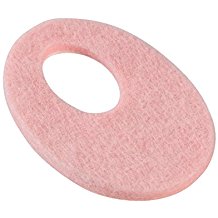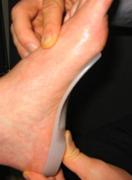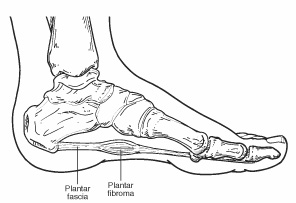 Lumps in the Arch – Home Treatment and Professional Treatment
Lumps in the Arch – Home Treatment and Professional Treatment
If you have found a lump in your arch, more than likely you have developed a plantar fibroma.
A plantar fibroma (also known as plantar fibromatosis) is a benign growth or nodule, really a thickening, of the plantar fascia – a thick ligament in the bottom of your foot. If you have found a bump or lump in your arch, make an appointment to see us in our Seattle foot and ankle clinic.
Video: How to Treat Plantar Fibromas
Cause of Plantar Fibromas
No one is quite sure of the cause of plantar fibomas, but there is evidence that trauma to the plantar fascia may cause them to form. The most common type of trauma is simply over-stretching of the plantar fascia due to the arch flattening too much. When the arch flattens, the foot gets longer and this stretches the fascia. In some people this excessive stretching can lead to formation of fibromas.
Are Plantar Fibromas Painful?
The fibroma itself doesn’t cause pain, but pressure on the lump can lead to pain in the arch when walking or standing.
Diagnosis of Arch Lumps
We can usually diagnose the lumps in your arch by examining your foot. If further information is required we can visualize the mass using diagnostic ultrasound in our office.
Treatment of Plantar Fibromas
Home Treatment of Plantar Fibromas
The goal of treatment is to:
- Reduce the pressure on the fibroma as much as possible
- Reduce the tension on the plantar fascia as much as possible.
Use a Prefabricated Orthotic to Reduce Tension on the Plantar Fascia
The best prefab orthotics for this condition will conform close to the arch of the foot to stop the foot from flattening and thus reduce the tension on the plantar fascia.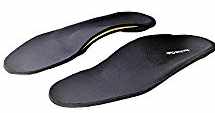
Our preferred prefabricated orthotic for plantar fibromas is the FootChair Orthotic with Adjustable Arch Height. This unique arch support comes with pads that can be added to the arch to increase the arch height so each person can find the most effective and comfortable arch height.
For smaller shoes including high heels, flats and smaller sport shoes such as soccer cleats, FootChair also makes a much slimmer 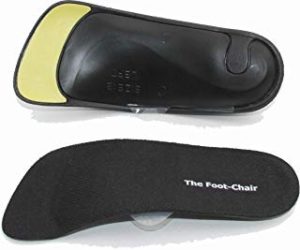 profile orthotic called the FootChair Slim Orthotic. The FootChair Slim as the same great adjustable arch but is much smaller. It also flexes to adjust to most heel heights.
profile orthotic called the FootChair Slim Orthotic. The FootChair Slim as the same great adjustable arch but is much smaller. It also flexes to adjust to most heel heights.
Adjust the FootChair Orthotic to Reduce Pressure on the Plantar Fibroma
Next, you should add a donut pad to the top of the orthotic so that the fibroma sits in the middle of the donut. Follow these instructions to do so:
- Mark the fibroma on your foot with lipstick
- Hold the orthotic against your foot so the lipstick transfers to the orthotic. This will show exactly where the pad should be place.

- Apply a Steins Adhesive Donut Pad (see image) to the orthotic with the lipstick mark centered in the hole.
If you have more than one fibroma on the same foot you can try two pads or cutting a second hole into the same pad. If that doesn’t work you will likely need a custom orthotic.
Custom Orthotics for Fibromas and Other Lumps in the Arch
Custom orthotics are the most effective treatment for plantar fibromas.
Orthotics must accomplish two things to best treat this problem:
- Decrease tension on the plantar fascia
- Decrease pressure on the lump in your arch
In order to effectively reduce both tension and pressure, orthotics for fibromas must:
- Conform very close to the arch of the foot (figure 2). Most orthotics we see made for fibromas do not conform close enougth (figure 3).

Fig 1: Close fitting orthotic
- Incorporate an indentation for the fibroma. This indentation should be very deep to best reduce pressure. Most orthotics we see for this problem either do not include an indentation or the indentation is too shallow.
- Be as wide as the entire foot in order to transfer pressure off of the fibromas. Most of the orthotics we see for this issue are simply too narrow.
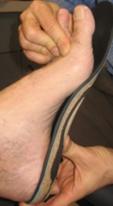
Fig 2: Orthotic gaps from arch
It’s critical that the orthotics act to maximally reduce tension and pressure on the fibromas in order to provide the best outcome so let’s go over this in more detail.
To decrease tension, we prescribe an orthotic that hugs your arch very close – this is called a total contact orthotic. By aggressively supporting your arch, we prevent the foot from flattening and decrease tension on the plantar fascia. By decreasing tension on the fascia you decrease tension on the fibroma.
We have to be very careful, however, because an orthotic that hugs your arch very close could irritate the plantar fibroma.
To prevent this, we have an indentation or pocket added to the orthotic exactly in the location of the fibroma. This acts to distribute pressure off of the lump. But to be effective this indentation must be both deeper and wider than the fibroma itself.
Too often orthotics for plantar fibromatosis simply do not have the indentation(s) or the indentation is much too shallow.
If made correctly orthotics are extremely effective at reducing the pain of plantar fibromas. If you have had orthotics made that have not been effective get a second opinion from a podiatrist who specializes in orthotic therapy.
We are experts in providing orthotics that are both extremely effective and comfortable. Make an appointment today to see us in our Seattle clinic.
Injections for Plantar Fibroma
Injection of the fibroma can be help shrink the fibroma in some patients. It doesn’t work all of the time, but many patients find this is the most effective way to make the lump smaller. Injection should always be done in conjunction with orthotics to help reduce pressure and tension on the fibroma.
Other Treatments for Fibromas
- Surgery: Surgical removal has also not been found to be very effective. The surgery itself has some significant side effects including flattening of the arch due to weakening of the plantar fascia. In addition, there is an extremely high likelihood of recurrence of the fibroma. We do not recommend surgery except in cases where nothing else has helped and there is significant pain.
- Topical Medication: There is one topical prescription cream that has been shown in a single study to help reduce plantar fibromas. We think that more study is needed to determine it’s true effectiveness, but we can discuss this with you at your appointment.





